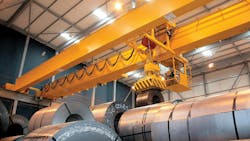Making the Most of Mobile Electrification in Manufacturing: 5 Things to Consider
Like most industries, manufacturing is and has been experiencing its fair share of supply chain disruptions, workforce shortages, and slowed operations. In fact, the National Association of Manufacturers Q1 2024 Manufacturers’ Outlook Survey shows that workforce retention is a primary pain point for 65% of manufacturers.
With lingering effects from the pandemic and rising economic uncertainties, it is important for manufacturers to think through ways to better optimize operations, improve workplace conditions, and support their employees.
Enter mobile electrification. Simply put, mobile electrification involves supplying electrical power to moving equipment using products such as conductor bar systems, festoon systems, and cable reels. These components ensure continuous and reliable power supply for industrial machinery in motion.
Designed to automate and enhance interconnectivity and communication, mobile electrification technologies can act as a holistic solution for your operations. From conductor bars to charging contacts, these technologies can seamlessly fit into your workflows, streamlining processes and improving workplace safety. When contemplating how mobile electrification can be adopted in your facility, here are five things to consider that can optimize your operations and push your business into the digital age.
1. Assess Current Infrastructure
The first consideration should be your current infrastructure. Is it equipped to handle mobile electrification implementation? How will these solutions impact your established workflows? What will downtime look like? These questions are essential to evaluate.
Before investing in new technology, manufacturers need to think through facility preparations and logistics and map out the best course of action for implementation. Keep in mind aspects like your floor and overhead space and the current power your warehouse is running on. Also, determine why you want to invest in mobile electrification and what your end goals are.
While implementing new technology is never a quick fix, it is essential to consider the long-term effects and outcomes. Investing in mobile electrification systems can have lasting benefits, improving internal communication and supporting enhanced warehouse and facility automation.
2. Determine Potential Operational Efficiency Gains
Next, take a deeper look into how mobile electrification can improve operational efficiency. Evaluating your current pain points is a good place to start. For example, your facility may be experiencing slowed operations due to using older equipment, affecting supply chain production. Leveraging mobile electrification solutions, like electrified monorail systems, can provide greater flexibility and versatility needed for day-to-day operations.
These solutions can easily integrate into existing operations and workflows and quickly adapt to changing production requirements or market demands. Designed for long-term ease of use with limited maintenance issues, employees can quickly learn how to use and operate these solutions, reducing extended downtime needed for adaptation.
READ MORE: Five Emerging Technology Trends for Mechanical Engineers
3. Take Safety & Workplace Conditions into Account
Ensuring safe working conditions is a primary consideration for all facilities. When contemplating new technology implementation, it is essential to prioritize safety and understand if and how it can improve workplace conditions for your employees.
To start, mobile electrification solutions provide noise reduction and improved air quality. For facility operators and employees who do not have the luxury of a hybrid work model, these are necessary factors that can positively improve workplace conditions and company morale.
These solutions are easy to use and operate, promoting enhanced safety and reducing the risk of potential incidents or equipment damage.
4. Consider the Environmental Impacts
Deploying mobile electrification solutions in manufacturing environments also has environmental sustainability impacts. It’s been reported that emissions from manufacturing are expected to increase by 17% between 2024 and 2050. With this in mind, businesses are starting to take into account their environmental impact and ways to establish sustainable best practices.
Implementing mobile electrification solutions is one sustainable strategy that can have lasting effects on employees and general operations. For example, electric equipment and vehicles produce zero tailpipe emissions, improving air quality within facilities and the environment.
READ MORE: Manufacturers Increase Sustainability Initiatives
5. Evaluate Possible Cost Benefits
Finally, consider how mobile electrification can improve your operational spending and generate a positive ROI (return on investment) for your business. It is no secret that electrically powered equipment garners an initial investment with the potential for onset downtime during implementation.
However, this process can generate positive long-term effects, including lower operating costs and enhanced equipment performance.
In terms of operations, switching to mobile electrification can act as a cost-effective solution. Some facilities rely on fuel like diesel or gas alternatives. However, these can contribute to costly spending as fuel prices continue to increase, and fuel is typically more volatile than electricity.
Mobile electrification technologies can also benefit facilities as they are regulatory compliant, removing any threats of compliance risk and potentially costly fines.
How to Take the Next Steps
Implementing new technology like mobile electrification into your manufacturing facility is not a change that can happen overnight. It should be a thoughtful process that requires reviewing your business goals and contemplating the long-term effects on your operations.
However, for those ready to take that next step, mobile electrification can improve your current systems by reducing workplace challenges, streamlining operations, and supporting the safety and well-being of your facility managers and employees.
This article was written and contributed by Stephanie LaFarr, Manager of Product Management at Conductix-Wampfler.
Editor’s Note: Power & Motion's WISE (Workers in Science and Engineering) hub compiles our coverage of workplace issues affecting the engineering field, in addition to contributions from equity seeking groups and subject matter experts within various subdisciplines.
About the Author

Stephanie LaFarr
Manager of Product Management
Stephanie LaFarr is Manager of Product Management at Conductix-Wampfler, a leader in the industrial electrification industry. Having worked for Conductix for over a decade, LaFarr is well-versed in the benefits of mobile electrification and has a deep understanding of the electrification industry.

Leaders relevant to this article:



